Pan Seared Chicken Breast with Sherry Thyme Pan Sauce
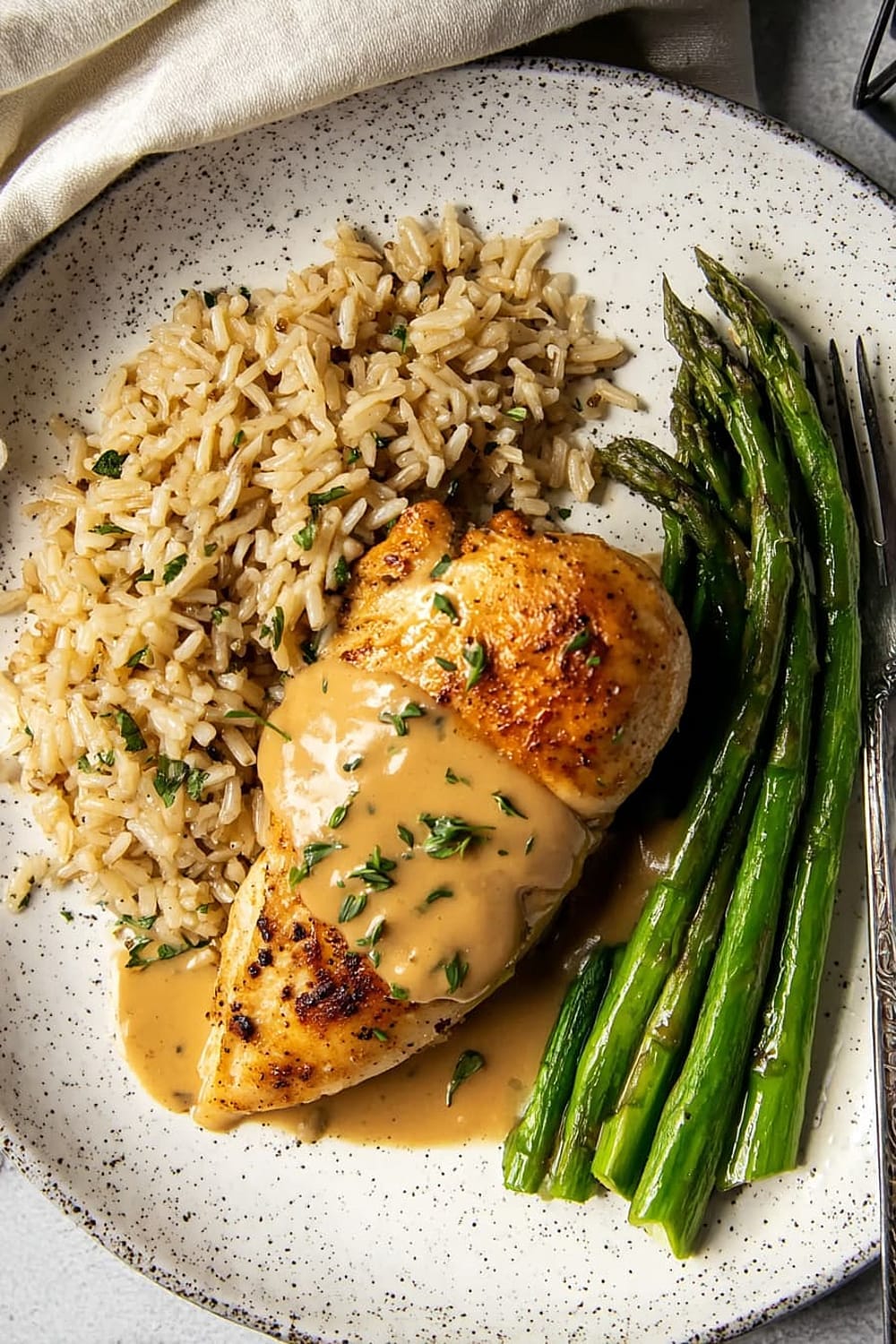
This recipe is basically the culinary equivalent of putting on a blazer over jeans – instantly elevating your dinner game without breaking a sweat.
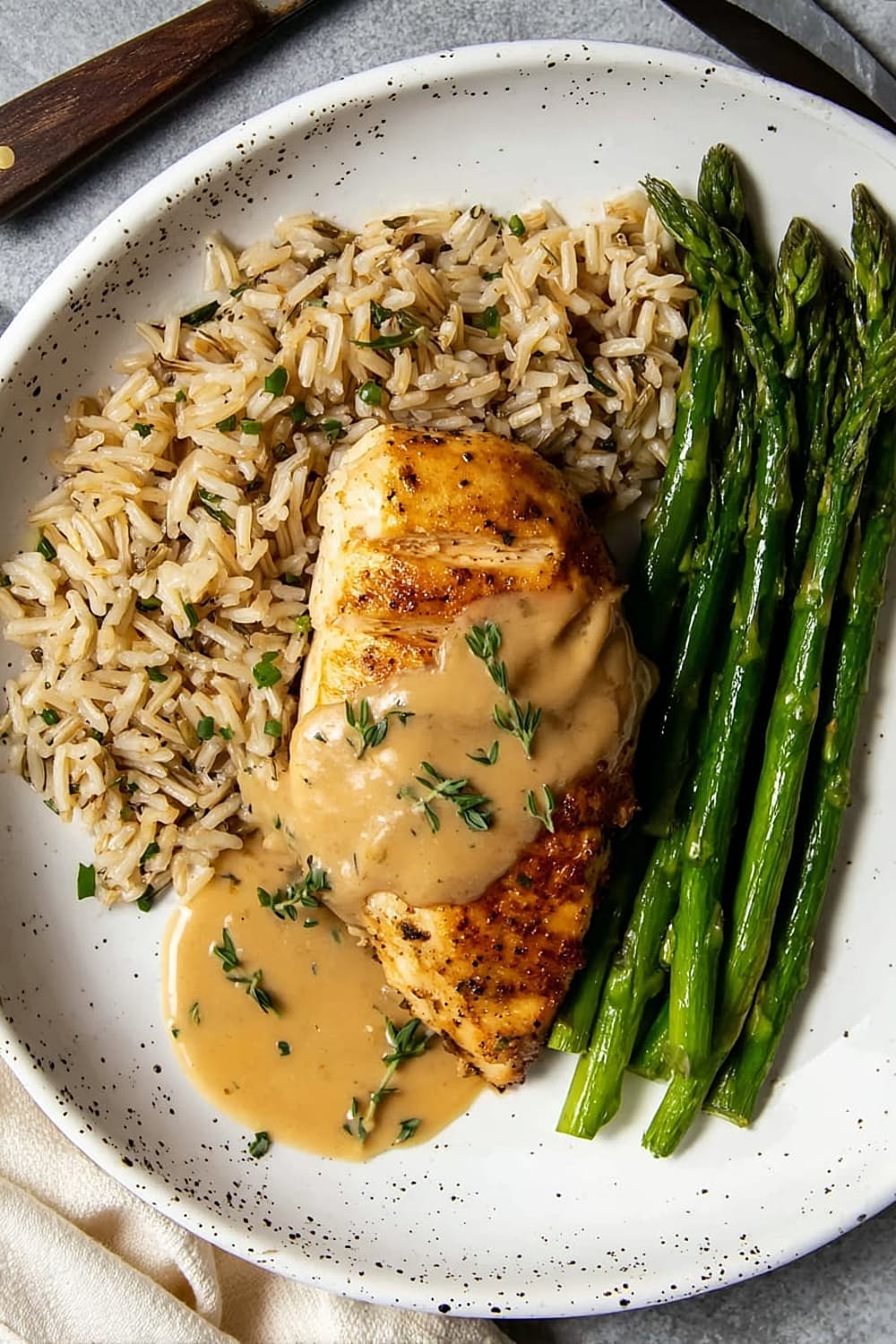
Picture this: golden-brown chicken that releases from the pan like it’s been professionally trained, creating the perfect canvas for a sauce that’ll make you question why you ever settled for plain grilled chicken.
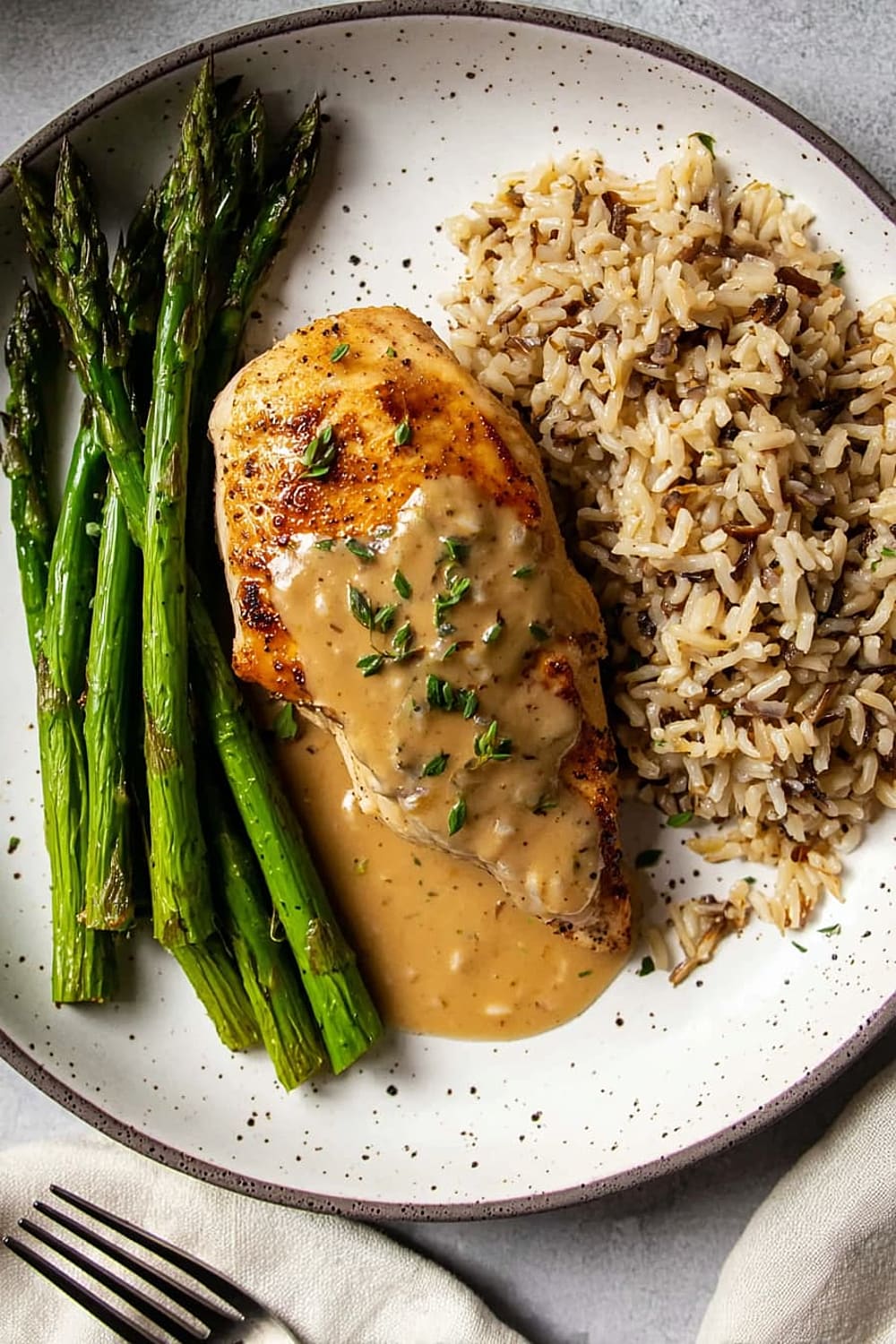
The sherry reduction creates this glossy, restaurant-quality pan sauce that tastes like you went to culinary school, but really you just followed some simple steps and trusted the process.
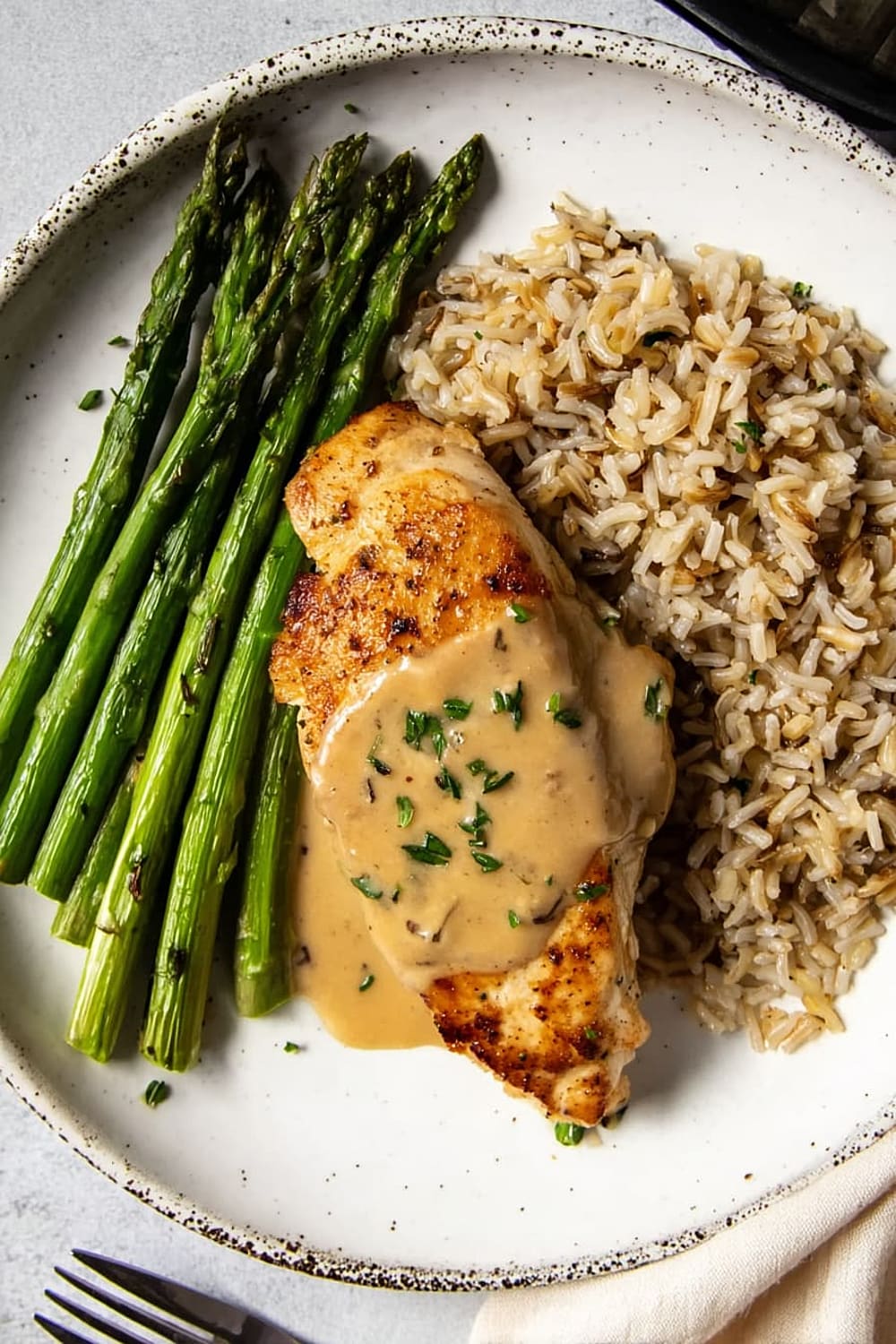
We’re talking about tender, juicy chicken breast that actually stays moist (yes, it’s possible) paired with a creamy thyme-infused sauce that’s rich enough to impress your mother-in-law.
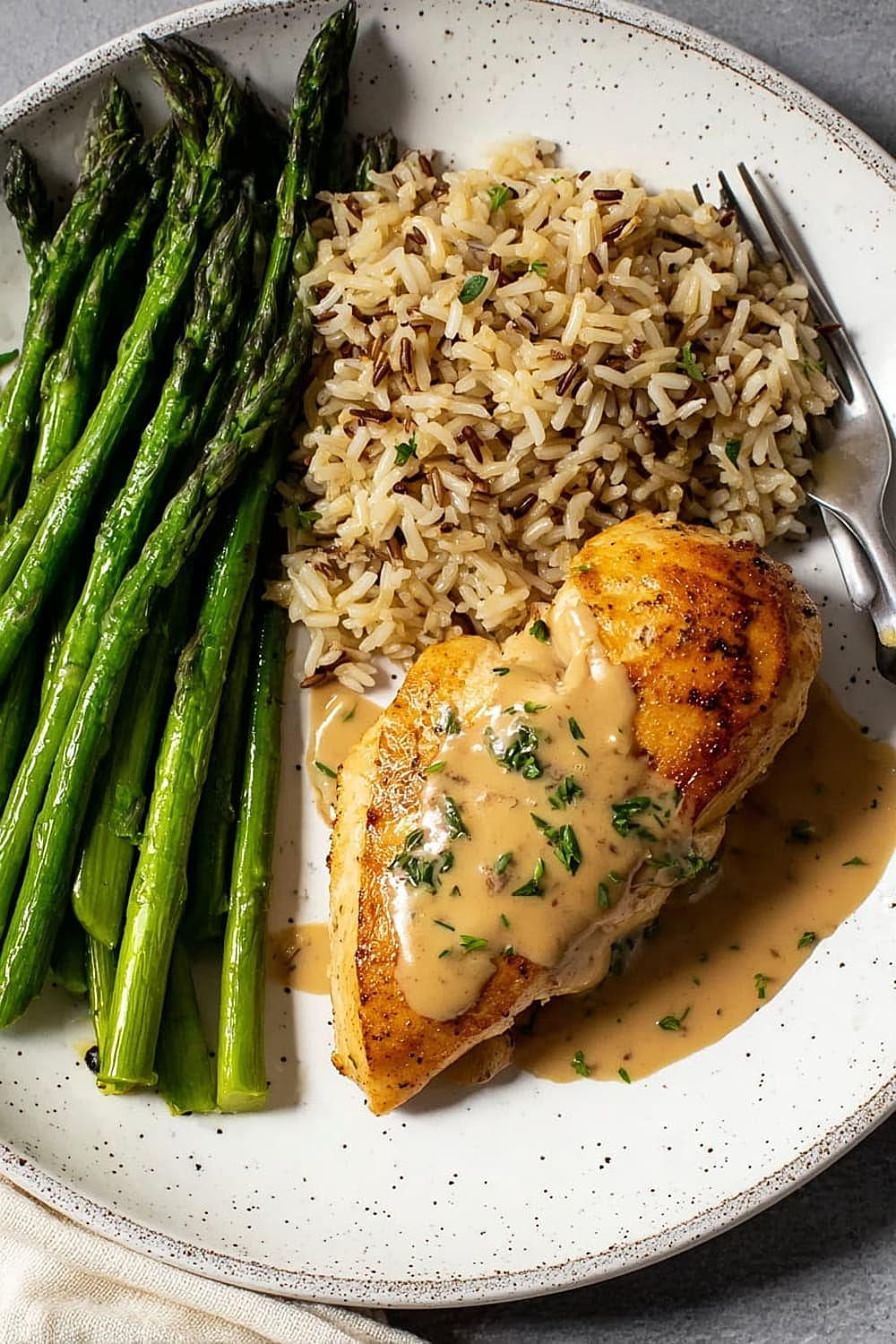
The best part is watching that sherry bubble and reduce while those beautiful brown bits from the chicken transform into liquid gold – it’s like kitchen magic happening right in your cast iron skillet.
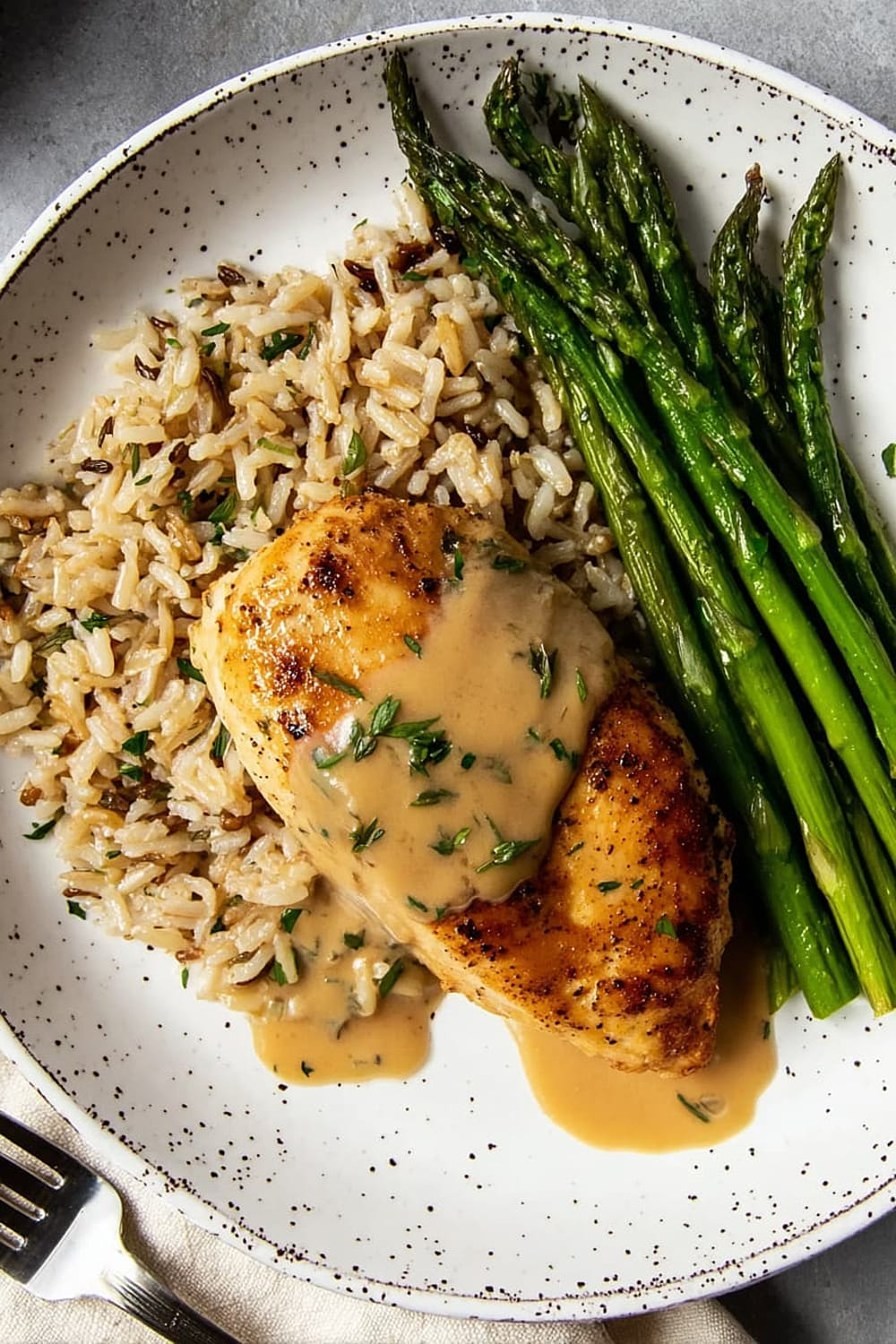
This is the kind of recipe that makes people assume you’re way more sophisticated than you actually are, and honestly, we’re here for that energy.
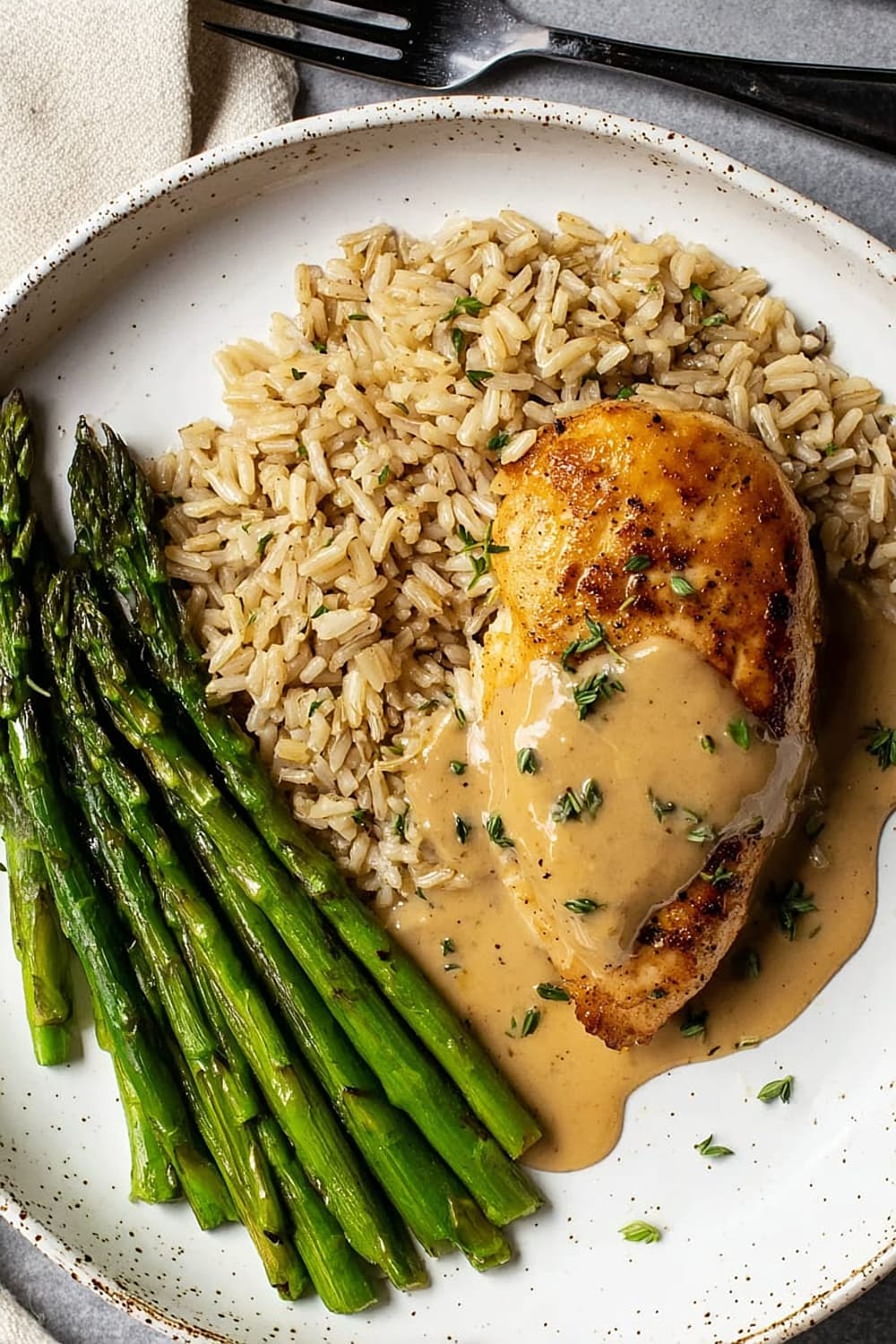
Ingredients
For the Chicken
- 4 5-ounce boneless, skinless chicken breasts
- Salt and freshly ground black pepper
- Olive oil for cooking
- 2 teaspoons butter
For the Sherry Thyme Pan Sauce
- 1 shallot, minced
- 2 sprigs fresh thyme
- 2 cups dry sherry
- 1 cup chicken stock
- 3 /4 cup heavy cream
- 1 tablespoon fresh thyme leaves for garnish
Instructions
Preparation
- 1 Preheat your oven to 170°F (77°C) – this low temperature will keep your chicken perfectly warm without overcooking while you prepare the sauce.
- 2 Season both sides of the chicken breasts generously with salt and freshly ground black pepper. Don’t be shy here; proper seasoning is what separates restaurant-quality chicken from bland disappointment.
Searing the Chicken
- 3 Heat a large sauté pan or cast iron skillet over medium-high heat until it’s hot but not smoking. Add a drizzle of olive oil and the 2 teaspoons butter, swirling to coat the pan evenly.
- 4 Reduce heat to medium and carefully place the seasoned chicken breasts in the pan. This is crucial – medium heat prevents burning while ensuring proper browning. Cook for 4-5 minutes per side without moving them. The chicken will release easily when it’s properly browned; if it’s sticking, it needs more time.
- 5 Transfer the beautifully browned chicken to a platter, loosely tent with aluminum foil, and place in the preheated 170°F (77°C) oven to keep warm while you create the sauce.
Creating the Pan Sauce
- 6 Add the minced shallot and 2 thyme sprigs to the same pan with all those gorgeous brown bits. Sauté until the shallots are lightly browned, about 2-3 minutes, stirring frequently to prevent burning.
- 7 Pour in the 2 cups dry sherry and immediately start scraping up those brown bits from the bottom of the pan with a wooden spoon – this is called deglazing and it’s where the magic happens. Bring to a simmer and cook for 3-4 minutes until the sherry reduces by half.
- 8 Stir in the 1 cup chicken stock and 3/4 cup heavy cream. Simmer for another 3-4 minutes until the sauce thickens slightly and coats the back of a spoon. Remove the thyme sprigs and season with salt and freshly ground black pepper to taste.
Finishing
- 9 Return the chicken to the skillet along with any accumulated juices from the platter. Simmer for just 2-3 more minutes to heat through and allow the flavors to meld.
- 10 Transfer the chicken to serving plates, spoon the luxurious sauce over the top, and garnish with fresh thyme leaves for that professional presentation.
Recommended Equipment and Kitchen Tools
Essential Tools (for best results)
- Cast iron skillet or heavy-bottomed sauté pan – The even heat distribution prevents hot spots and creates perfect browning without burning
- Instant-read thermometer – Takes the guesswork out of checking doneness; chicken should reach 165°F (74°C) internally
- Wooden spoon or silicone spatula – Perfect for deglazing and scraping up those flavorful brown bits without scratching your pan
- Aluminum foil – Essential for tenting the chicken to keep it warm and moist
Helpful Upgrades
- Digital kitchen scale – For precise portion control if you’re buying whole chicken breasts and cutting them yourself
- Fine-mesh strainer – Optional for straining the sauce if you prefer an ultra-smooth finish
- Microplane grater – Makes quick work of zesting or grating fresh ingredients for variations
Nice-to-Have Options
- Warming drawer or low oven – Professional kitchens use this technique to hold proteins at perfect serving temperature
- Quality tongs – Makes flipping and handling the chicken breasts much easier and safer than using a fork
Recipe Variations and Dietary Modifications
Wine Substitutions
- White wine → Use Chardonnay or Sauvignon Blanc in place of sherry for a lighter, more acidic sauce
- Marsala wine → Creates a deeper, slightly sweet flavor profile similar to the classic veal marsala
- Non-alcoholic option → Replace sherry with additional chicken stock plus 2 tablespoons white wine vinegar for acidity
Cream Alternatives
- Half-and-half → Reduces richness while maintaining creaminess; simmer longer to thicken
- Greek yogurt → Stir in 1/2 cup at the very end off heat to prevent curdling
- Coconut cream → Full-fat canned coconut milk creates a dairy-free version with tropical notes
Herb Variations
- Rosemary and sage → Perfect for fall flavors; use half the amount as these herbs are more potent
- Tarragon and chives → Creates a French-inspired sauce with bright, anise-like notes
- Lemon thyme and oregano → Mediterranean twist that pairs beautifully with the sherry
Protein Swaps
- Pork tenderloin → Slice into medallions and adjust cooking time to 3-4 minutes per side
- Turkey cutlets → Cook for 2-3 minutes per side as they’re thinner than chicken breasts
- Thick fish fillets → Halibut or cod work well; reduce cooking time to 3-4 minutes per side
Nutritional Information and Health Benefits
Key Nutritional Highlights
Each serving provides approximately 420 calories with 35 grams of high-quality complete protein from the chicken breast. The dish contains about 18 grams of fat primarily from the heavy cream and butter, while carbohydrates remain low at roughly 8 grams per serving, making it suitable for low-carb eating plans.
Health Benefits of Main Ingredients
Chicken breast is an excellent source of lean protein, providing all essential amino acids needed for muscle maintenance and repair. The fresh thyme contains compounds like thymol and carvacrol, which have natural antimicrobial and antioxidant properties. Shallots belong to the allium family and provide quercetin, a powerful flavonoid that supports heart health and has anti-inflammatory effects. The cooking method preserves most nutrients while the pan sauce adds minimal calories compared to heavier cream-based dishes.
Dietary Considerations
This recipe is naturally gluten-free and keto-friendly, containing less than 10 grams of carbohydrates per serving. It’s rich in B vitamins, particularly niacin and B6 from the chicken, which support energy metabolism. The moderate fat content helps with satiety and absorption of fat-soluble vitamins. Those watching sodium should be mindful of seasoning levels and choose low-sodium chicken stock.
Smart Swaps and Ingredient Substitutions
Common Substitutions:
- Heavy cream → Half-and-half or whole milk (simmer longer to thicken) or cashew cream for dairy-free
- Dry sherry → White wine, Marsala, or even dry vermouth in equal amounts
- Fresh thyme → Dried thyme using 1/3 the amount or fresh rosemary for different flavor profile
- Shallots → Yellow onion (use half the amount) or green onions for milder flavor
Budget-Friendly Swaps:
- Chicken stock → Bouillon cubes or powder mixed with water (reduce added salt accordingly)
- Heavy cream → Whole milk thickened with 1 tablespoon cornstarch slurry
- Dry sherry → White cooking wine from the grocery store (not as complex but functional)
Pantry Emergency Substitutions:
- Fresh thyme → Italian seasoning or herbes de Provence (1/2 teaspoon)
- Shallots → Garlic powder (1/2 teaspoon) plus onion powder (1 teaspoon)
- Chicken stock → Water plus chicken bouillon paste or even vegetable broth
Pro Tips for Substitutions:
- When using milk instead of cream, add 1 tablespoon butter at the end for richness
- Taste and adjust seasoning when making substitutions as flavor profiles change
- Store opened sherry in the refrigerator for up to 6 months for future cooking
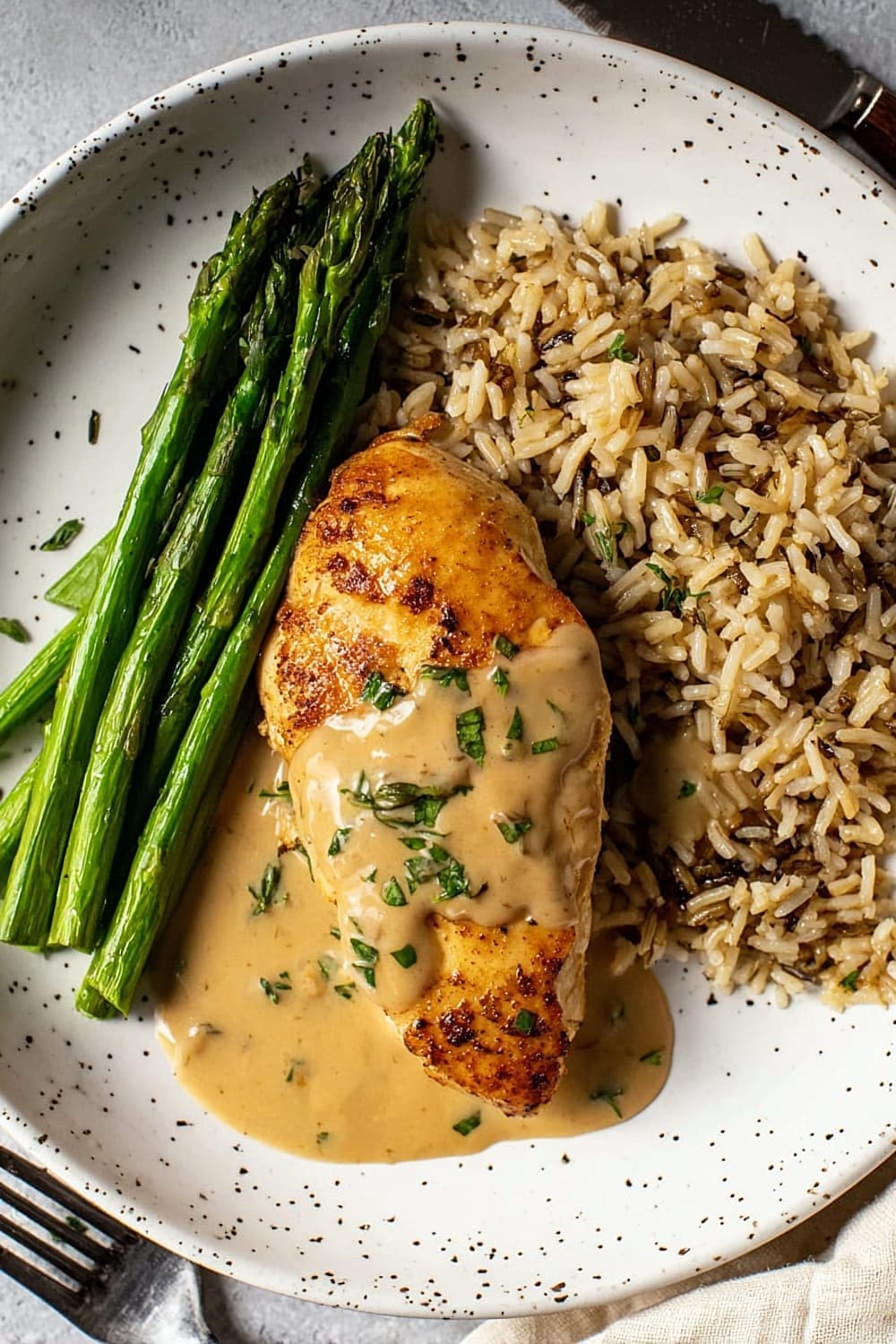
Make It Diabetes-Friendly
Carb Reduction Strategies:
- This recipe is naturally low in carbohydrates with only 6-8 grams per serving, primarily from the shallots and small amount of natural sugars in the sherry
- The alcohol in sherry cooks off during reduction, leaving behind flavor compounds without the alcohol content
- Serve with cauliflower rice or zucchini noodles instead of traditional starches to keep the meal under 15 grams total carbs
Portion & Blood Sugar Management:
- The high protein content (35 grams per serving) helps stabilize blood sugar levels and promotes satiety
- Healthy fats from the cream provide sustained energy without blood sugar spikes
- Consider pairing with fiber-rich vegetables like roasted broccoli or sautéed spinach to further slow glucose absorption
Modification Options:
- Replace heavy cream with unsweetened almond milk thickened with 1 tablespoon cream cheese for lower carbs
- Use bone broth instead of regular chicken stock for added minerals and collagen benefits
- Add extra herbs and spices for flavor without carbohydrates
Total Carb Content: Approximately 6-8 grams per serving as written, making it excellent for diabetic meal planning

Perfect Pairing Suggestions
Beverage Pairings
A crisp Chardonnay or Sauvignon Blanc complements the sherry reduction beautifully, while the wine’s acidity cuts through the cream sauce. For red wine lovers, a light Pinot Noir won’t overpower the delicate chicken. Non-alcoholic options include sparkling water with lemon or unsweetened iced tea with fresh herbs. The rich sauce pairs surprisingly well with a bold coffee if serving as a brunch dish.
Side Dish Recommendations
Roasted asparagus or green beans provide a crisp contrast to the creamy sauce, while their slight bitterness balances the rich flavors. Garlic mashed cauliflower offers comfort without the carbs, and wild rice pilaf adds nutty texture that soaks up the sauce perfectly. For lighter options, try arugula salad with lemon vinaigrette or roasted Brussels sprouts with bacon.
Complete Meal Ideas
Start with a simple mixed greens salad, serve the chicken as the main course with roasted vegetables, and finish with lemon sorbet or fresh berries. For entertaining, add crusty bread for sauce sopping and a cheese board for appetizers. The elegant presentation makes this perfect for date nights, dinner parties, or Sunday family dinners.
Seasonal Considerations
Spring calls for fresh peas and baby potatoes, summer pairs with grilled zucchini and tomato salad, fall begs for roasted root vegetables, and winter demands creamy polenta or mashed potatoes to embrace the comfort factor fully.
Pro Tips and Troubleshooting
Professional Techniques
Always let your pan get properly hot before adding the chicken – you should hear an immediate sizzle when the protein hits the surface. Don’t move the chicken once it’s in the pan; it will release naturally when properly browned. The key to a glossy pan sauce is proper emulsification – whisk in cold butter at the end if you want restaurant-level shine. Taste and adjust seasoning at every step, especially after adding the cream which can dull flavors.
Common Mistakes to Avoid
Overcrowding the pan creates steam instead of browning, so cook in batches if necessary. Don’t rush the sherry reduction – proper evaporation concentrates flavors and removes harsh alcohol notes. Adding cream to a rolling boil can cause curdling; always reduce heat to a gentle simmer first. Skipping the resting step means losing precious juices that should go back into the sauce.
Storage and Reheating
Store leftover chicken and sauce separately in the refrigerator for up to 3 days. Reheat chicken gently in a 300°F (150°C) oven to prevent drying out, and warm the sauce in a small saucepan over low heat, whisking frequently. The sauce may separate when cold but will come back together when gently reheated. This dish doesn’t freeze well due to the cream base, but the chicken can be frozen without sauce for up to 2 months.
This pan-seared chicken with sherry thyme sauce proves that restaurant-quality meals don’t require professional training or expensive ingredients – just good technique and attention to detail. The combination of perfectly browned protein and silky pan sauce creates a dish that’s impressive enough for special occasions yet simple enough for weeknight dinners. Master this recipe, and you’ll have a go-to technique that works with virtually any protein and sauce combination, opening up endless possibilities for your culinary repertoire.